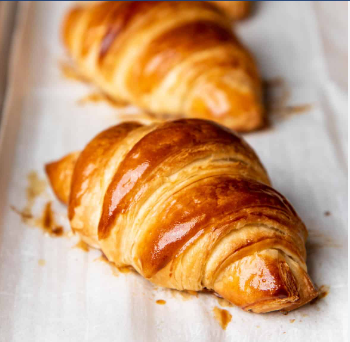Embark on a journey of culinary mastery as we unravel the secrets behind crafting the perfect croissant—the epitome of French pastry artistry. Derived from the same lean baguette dough, this recipe takes a delightful twist with the addition of milk and a touch of sugar, resulting in the ethereal layers and buttery crispness that define the classic croissant. The meticulous lamination process, where butter and dough intertwine in a dance of flavors, brings forth a marvel of engineering that captivates both the eyes and the taste buds. Prepare to indulge in the exquisite fusion of technique and taste, where every bite of these freshly baked croissants evokes a moment of pause and appreciation for the culinary craft.
INGREDIENTS:
- POOLISH
- 200 grams of all-purpose flour
- 200 grams water (75°F)
- 3 grams of active dry yeast
- LEAVEN
- 1 tablespoon mature starter (page 45)
- 220 grams of all-purpose flour
- 220 grams of water (80°F)
- CROISSANTS
- Whole Milk 450 grams
- Leaven 300 grams
- Poolish 400 grams
- Bread Flour 1,000 grams (1 kilogram)
- Salt 28 grams
- Sugar 85 grams
- Active Dry Yeast 10 grams
- Cold Unsalted Butter 400 grams
- 1/2 cup all-purpose flour
- EGG WASH
- 2 large egg yolks
- 1 teaspoon heavy cream
PREPARATIONS:
- Prepare the poolish by mixing all-purpose flour, water, and active dry yeast. Let it stand for 3 to 4 hours at 75°F or overnight in the refrigerator.
- Create the leaven by combining mature starter, all-purpose flour, and water. Set aside.
- For the croissants, mix whole milk, leaven, and poolish, then add bread flour, salt, sugar, and active dry yeast.
- Incorporate the cold unsalted butter and all-purpose flour to form the croissant dough.
SPECIAL INSTRUCTIONS:
- The lamination process creates alternating layers of dough and butter for the croissants.
TIPS:
- Maintain precise measurements and follow each step meticulously for optimal results.
- Keep the butter and dough cold during the lamination process to achieve the desired flaky texture.
YIELD:
- Makes 14 to 16 croissants
The art of crafting croissants stands as a testament to the harmonious blend of science and gastronomy. This revered French pastry, born from the humble baguette dough, takes a transformative journey through the alchemy of ingredients and technique, emerging as a masterpiece that captures the heart and palate alike.
As you embark on the creation of these croissants, the anticipation builds, for each step, from the creation of the poolish to the delicate lamination process, is a step closer to experiencing the sheer delight of these golden, flaky wonders. The interplay of the cold unsalted butter and the supple dough, meticulously enveloped in layers, culminates in a texture that is at once crisp and tender—a symphony of contrasts that harmonize in each bite.
Baking croissants transcends the realm of mere culinary endeavor; it is an homage to the craftsmanship that transcends generations. With each bite, you are not just savoring a pastry; you are immersing yourself in a tradition that speaks of dedication, precision, and a passion for creating perfection. The croissants, adorned with a delicate egg wash, beckon you to savor their intricate flavors and textures—a reminder that the most extraordinary experiences often arise from the simplest of ingredients.
As these freshly baked croissants emerge from the oven, their intoxicating aroma fills the air, inviting you to partake in a ritual that has graced tables around the world for centuries. Whether enjoyed as a morning indulgence or as an elegant accompaniment to afternoon tea, these croissants are a tribute to the art of baking—a testament to the fact that true mastery lies in the marriage of technique and taste.


